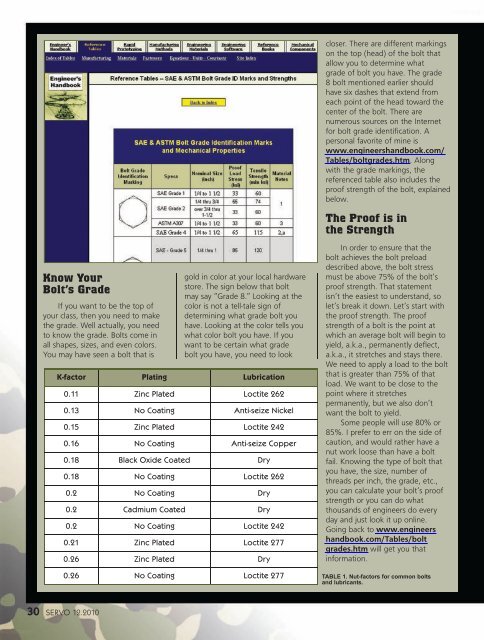Create successful ePaper yourself
Turn your PDF publications into a flip-book with our unique Google optimized e-Paper software.
worldmags<br />
Know Your<br />
Bolt’s Grade<br />
If you want to be the top of<br />
your class, then you need to make<br />
the grade. Well actually, you need<br />
to know the grade. Bolts come in<br />
all shapes, sizes, <strong>and</strong> even colors.<br />
You may have seen a bolt that is<br />
30 SERVO 12.2010<br />
gold in color at your local hardware<br />
store. The sign below that bolt<br />
may say “Grade 8.” Looking at the<br />
color is not a tell-tale sign of<br />
determining what grade bolt you<br />
have. Looking at the color tells you<br />
what color bolt you have. If you<br />
want to be certain what grade<br />
bolt you have, you need to look<br />
K-factor Plating Lubrication<br />
0.11 Zinc Plated Loctite 262<br />
0.13 No Coating Anti-seize Nickel<br />
0.15 Zinc Plated Loctite 242<br />
0.16 No Coating Anti-seize Copper<br />
0.18 Black Oxide Coated Dry<br />
0.18 No Coating Loctite 262<br />
0.2 No Coating Dry<br />
0.2 Cadmium Coated Dry<br />
0.2 No Coating Loctite 242<br />
0.21 Zinc Plated Loctite 277<br />
0.26 Zinc Plated Dry<br />
closer. There are different markings<br />
on the top (head) of the bolt that<br />
allow you to determine what<br />
grade of bolt you have. The grade<br />
8 bolt mentioned earlier should<br />
have six dashes that extend from<br />
each point of the head toward the<br />
center of the bolt. There are<br />
numerous sources on the Internet<br />
for bolt grade identification. A<br />
personal favorite of mine is<br />
www.engineersh<strong>and</strong>book.com/<br />
Tables/boltgrades.htm. Along<br />
with the grade markings, the<br />
referenced table also includes the<br />
proof strength of the bolt, explained<br />
below.<br />
The Proof is in<br />
the Strength<br />
In order to ensure that the<br />
bolt achieves the bolt preload<br />
described above, the bolt stress<br />
must be above 75% of the bolt’s<br />
proof strength. That statement<br />
isn’t the easiest to underst<strong>and</strong>, so<br />
let’s break it down. Let’s start with<br />
the proof strength. The proof<br />
strength of a bolt is the point at<br />
which an average bolt will begin to<br />
yield, a.k.a., permanently deflect,<br />
a.k.a., it stretches <strong>and</strong> stays there.<br />
We need to apply a load to the bolt<br />
that is greater than 75% of that<br />
load. We want to be close to the<br />
point where it stretches<br />
permanently, but we also don’t<br />
want the bolt to yield.<br />
Some people will use 80% or<br />
85%. I prefer to err on the side of<br />
caution, <strong>and</strong> would rather have a<br />
nut work loose than have a bolt<br />
fail. Knowing the type of bolt that<br />
you have, the size, number of<br />
threads per inch, the grade, etc.,<br />
you can calculate your bolt’s proof<br />
strength or you can do what<br />
thous<strong>and</strong>s of engineers do every<br />
day <strong>and</strong> just look it up online.<br />
Going back to www.engineers<br />
h<strong>and</strong>book.com/Tables/bolt<br />
grades.htm will get you that<br />
information.<br />
0.26 No Coating Loctite 277 TABLE 1. Nut-factors for common bolts<br />
<strong>and</strong> lubricants.<br />
worldmags




